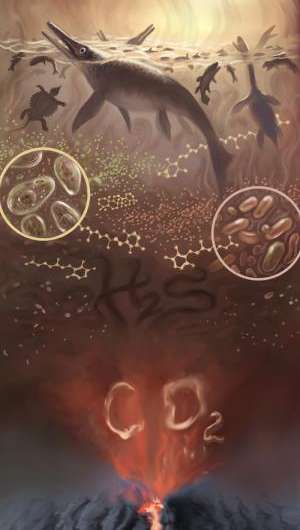Oxygen-depleted toxic oceans had key role in mass extinction over 200 million years ago

Changes in the biochemical balance of the ocean were a crucial factor in the end-Triassic mass extinction, during which half of all plant, animal and marine life on Earth perished, according to new research involving the University of Southampton.
The study, published in the upcoming edition of Geology, reveals that a condition called 'marine photic zone euxinia' took place in the Panathalassic Ocean- the larger of the two oceans surrounding the supercontinent of Pangaea.
Photic zone euxinia occurs when the sun-lit surface waters of the ocean become devoid of oxygen and are poisoned by hydrogen sulphide - a by-product of microorganisms that live without oxygen that is extremely toxic to most other lifeforms.
The international team of researchers studied fossilised organic molecules extracted from sedimentary rocks that originally accumulated on the bottom of the north-eastern Panthalassic Ocean, but are now exposed on the Queen Charlotte Islands, off the coast of British Columbia, Canada.
The team found molecules derived from photosynthesising brown-pigmented green sulphur bacteria - microorganisms that only exist under severely anoxic conditions - proving severe oxygen depletion and hydrogen sulphide poisoning of the upper ocean at the end of Triassic, 201 million years ago.
The researchers also documented marked changes in the nitrogen composition of organic matter, indicating that disruptions in marine nutrient cycles coincided with the development of low oxygen conditions.
Previous studies have reported evidence of photic zone euxinia from terrestrial and shallow, near-shore environments during the latest Triassic, but the new research is the first to provide such evidence from an open ocean setting, indicating these changes may have occurred on a global scale.
The University of Southampton's Professor Jessica Whiteside, who co-authored the study, explains: "As tectonic plates shifted to break up Pangaea, huge volcanic rifts would have spewed carbon dioxide into the atmosphere, leading to rising temperatures from the greenhouse effect. The rapid rises in CO2 would have triggered changes in ocean circulation, acidification and deoxygenation."
"These changes have the potential to disrupt nutrient cycles and alter food chains essential for the survival of marine ecosystems. Our data now provides direct evidence that anoxic, and ultimately euxinic, conditions severely affected food chains."
"The same CO2 rise that led to the oxygen depleted oceans also led to a mass extinction on land, and ultimately to the ecological take-over by dinosaurs, although the mechanisms are still under study."
Although the Earth was very different during the Triassic Period compared to today, the rate of carbon dioxide release from volcanic rifts are similar to those that we are experiencing now through the burning of fossil fuels.
Professor Whiteside comments: "The release of CO2 was probably at least as rapid as that caused by the burning of fossil fuels today, although the initial concentrations were much higher in the Triassic. The consequences of rapidly rising CO2 in ancient times inform us of the possible consequences of our own carbon dioxide crisis."
More information: "Episodic photic zone euxinia in the northeastern Panthalassic Ocean during the end-Triassic extinction." Geology April 2015 DOI: 10.1130/G36371.1
Journal information: Geology
Provided by University of Southampton




















